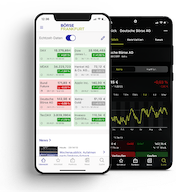Marktstimmung: "No way through"

While other major markets are thriving, this is driving some local investors out of the market. Joachim Goldberg knows what this could mean.
Summary
The small gain of the DAX since last Wednesday, with a range of just over 2 percent, has prompted professional bulls and bears alike to move to the sidelines. The sentiment index remains virtually unchanged at +12 points. According to Joachim Goldberg, at least those on the long side were able to take profits. The situation was different for private investors, 6 percent of whom exited their short positions and moved to the sidelines. Their sentiment index remains virtually unchanged at +13 points.
The behavioral economist now sees the range for German blue chips at 23,250/23,300 points on the downside and 23,800/850 on the upside. However, the downside limit is more permeable. However, the group on the sidelines is very small, so demand from international investors is needed to break out of the sideways movement.
24 September 2025. FRANKFURT (Goldberg & Goldberg). Of the three extreme risks that international fund managers fear most, according to a survey conducted by Bank of America last week, none are taken particularly seriously by stock market traders. Neither the possibility of inflation flaring up again in the US – currently ranked number one among extreme risks – nor the possible loss of independence of the US Federal Reserve in connection with fears of a devaluation of the dollar or a potentially uncontrolled rise in US government bond yields caused serious concern.
The Fed's interest rate decision last Wednesday, along with all interest rate forecasts, was even greeted with new all-time highs on the US markets (S&P 500 and Nasdaq). But here in Germany, the DAX failed to gain significant momentum on the downside, and another attempt to break through the important level of 23,750/800 on the upside was once again doomed to failure. At least the DAX still managed to post a gain of 0.6 percent for the week.
The margins exploited
In fact, despite several attempts, the DAX has not seen the 23,900 mark since September 2, while at the same time the downside is less pronounced. It is therefore not surprising that we find only a slight change in sentiment among the institutional investors with a medium-term trading horizon that we surveyed compared to the previous week: our Frankfurt Stock Exchange Sentiment Index has fallen by just one point to a new level of +12. However, some players have used the DAX's 2.1 percent range to reduce their exposure. As a result, the bull camp has shrunk by 4 percentage points and the bear camp by 3 percentage points in favor of neutral investors (+7 percentage points). In other words, the polarization between bulls and bears has decreased (slightly asymmetrically to the detriment of the bulls).
The situation is somewhat different for private investors. The Frankfurt Stock Exchange Sentiment Index in this panel rose by 6 points to a new level of +13, with investors who were not surveyed via social media setting the tone. In this subgroup, bearish positions were primarily reduced—the bear camp shrank by 10 percentage points—which almost exclusively benefited the group of neutral investors. Optimism has also risen once again among those we surveyed via social media; in this subgroup, 62 percent of respondents are now bullish.
Domestic investors locked in
Today's sentiment survey shows that private and institutional investors are now almost neck and neck. However, the optimism of private investors who we do not survey via social media lags significantly behind that of their institutional counterparts, which is why the Frankfurt Stock Exchange Sentiment Index stands at only +4 in this subgroup.
Among institutional investors in particular, it is clear that fundamental/economic arguments were probably less responsible for the repositioning than technical factors influencing prices. Optimists have thus taken profits at the upper end, which we now estimate at 23,800/850 DAX points. On the downside, where we expect demand in the 23,250/300 range, bears have been particularly active in reducing their exposure. Ultimately, however, the group of neutral investors, accounting for 18 percent of all respondents, is not large enough to significantly strengthen the outer limits of this zone through corresponding new supply or new demand. Even though today's survey suggests that these levels are likely to be somewhat more permeable than before, with the downside appearing softer, inflows or outflows from long-term investors are needed to push the DAX out of its sideways zone. And here, it seems that the underside is more likely to be at risk of such a breakthrough.
by Joachim Goldberg
24 September 2025, © Goldberg & Goldberg for boerse-frankfurt.de
Sentiment index of institutional investors

| Bullish | Bearish | Neutral | |
|---|---|---|---|
| Total | 47% | 35% | 18% |
| vs. last survey | -4% | -3% | +7% |
DAX (change since last survey): 23.600 Points (+130 points since last survey)
Frankfurt Stock Exchange Sentiment Index for institutional investors: 12 Points (-1 points since last survey)
Sentiment index of private investors

| Bullish | Bearish | Neutral | |
|---|---|---|---|
| Total | 45% | 32% | 23% |
| vs. last survey | +0% | -6% | +6% |
DAX (change since last survey): 23.600 points (+130 points since last survey)
Frankfurt Stock Exchange Sentiment Index for private investors: 13 points (+6 points since last survey)
About the Frankfurt Stock Exchange Sentiment Index
The Frankfurt Stock Exchange Sentiment Index ranges between -100 (total pessimism) and +100 (total optimism), with the transition from positive to negative values marking the neutral line.
More articles from this columnist
| Time | Title |
|---|





